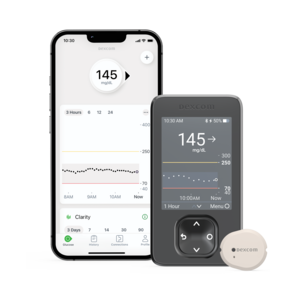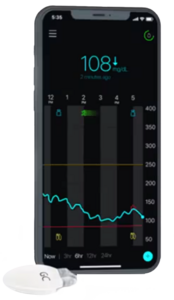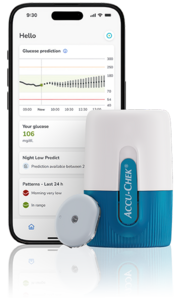What is a Continuous Glucose Monitor (CGM)?
A continuous glucose monitor tracks glucose levels in real-time, providing critical data for diabetes management. Unlike traditional meters that require fingerstick tests, CGMs measure glucose every 1–5 minutes, offering 288+ readings per day and displaying trends over the past 1 to 24 hours. Real-time feedback highlights the factors that impact your glucose. You can modify insulin doses, pump settings, food selections, or behaviors for effective solutions.
Why Use a CGM?
- No More Finger Pricks – Reduces or eliminates the need for frequent blood sampling.
- Real-Time Data – Identifies glucose trends and fluctuations.
- Smart Alerts – Notifies users of high or low glucose levels.
- Better Diabetes Control – Helps adjust insulin, food intake, and activity to stay in range.
- Improved Outcomes – Lowers A1c by 0.5–1.0% and increases Time in Range (TIR).
How CGMs Work
CGMs consist of three key components:
- Sensor – A tiny sensor inserted under the skin measures glucose in interstitial fluid.
- Transmitter – Sends glucose readings to a phone, insulin pump, or dedicated receiver.
- Receiver/App – Displays real-time glucose data and trend arrows.
Most sensors last 7 to 15+ days, while implanted sensors (Eversense 365) last up to a year. Sensors use enzymatic reactions or fluorescence technology to measure glucose and transmit data wirelessly.
Enzymes within an inserted sensor wire interact with glucose in the interstitial fluid surrounding the cells, converting a chemical reaction into electrical signals. The transmitter on the skin above the sensor sends these electric signals to a pump, smartphone, or dedicated receiver for conversion into glucose readings. The implanted 365-day Senseonics sensor differs by measuring glucose beneath the skin using fluorescence and transmitting this information to a receiver on the skin’s surface above it.
Benefits of CGM Alerts
- Prediction Alerts – Warn about impending highs/lows.
- Threshold Alerts – Signal when glucose exceeds safe limits.
- Rate-of-Change Alerts – Detect rapid glucose shifts.
- Trend Lines and Arrows – Show glucose direction and speed to guide decisions.
CGMs enable proactive adjustments in insulin dosing, meal timing, and activity levels to prevent extreme highs and lows. Act promptly when an alert sounds to prevent extreme lows and highs! CGM high alerts help identify missed boluses, low glucose levels, loose or disconnected infusion sets, occlusions, and the effects of stress and exercise. They also enable you to adjust the pump’s bolus recommendations and your basal and bolus settings.
Low alerts minimize hypoglycemia risks that are crucial for individuals who live alone, work in high-risk occupations, or aim to maintain tighter glucose levels before conception or during pregnancy. CGM and AID alerts are critical for parents or caregivers of children too young to express symptoms of low or high glucose levels.
Choosing the Best CGM in 2025
Key factors include accuracy, wear duration, cost, insurance coverage, and integration with insulin pumps and diabetes apps.
| CGM Model | Wear Duration | MARD (Accuracy) | Features |
|---|---|---|---|
| Dexcom G7 |
15.5 days |
8.2% |
Best accuracy, smartphone alerts, pump integration |
| FreeStyle Libre 3+ |
15 days |
7.9% |
Budget-friendly, real-time glucose updates |
| Medtronic Simplera |
7 days |
10.2% |
Expected to work with Medtronic pumps, has predictive alerts, may be joined by Libre 3+ for increased wear time and accuracy |
| Eversense 365 |
365 days |
8.8% |
Implanted sensors and daily calibrations are recommended |
1.7 When to Verify a CGM with a Fingerstick
- Calibrate your CGM any time the CGM reading differs from a finger-stick reading by over 20 mg/dl (1.1 mmol/L) at a glucose below 200 mg/dl (11.1 mmol/L) or by 30 gm/dl (1.7 mmol/L) for readings above 200 mg/dl
- Any time your symptoms differ from the CGM’s reading.
- When recent CGM readings have been erratic.
- When a correction bolus does not lower a high glucose within 3 hours.
- Before driving, especially if your trend line or arrow is falling.
- When the CGM reads low at night, the sensor was possibly compressed by sleeping on it.
After treating low glucose, fingerstick readings are more accurate than the CGM for 20 to 30 minutes.
Calibration
CGM sensor readings typically align closely with meter values, but exercise caution when a CGM’s readings differ significantly from fingerstick measurements. Fig. 1.7 from Pumping Insulin with Automated Insulin Delivery shows when to verify your CGM reading with a fingerstick reading.
Insurance & Cost Considerations
- Medicare & Insurance: Covers Dexcom and Libre CGMs for people with Type 1 or Type 2 diabetes using insulin. Some people having hypoglycemia may qualify even without insulin.
- Cost Without Insurance:
- Libre 3+: ~$230 per month (30 days)
- Dexcom G7: ~$335 per month (30 days)
- Eversense 365: Higher upfront cost with lower long-term expenses.
Typically, Medicare covers 80% of the approved amount for CGM devices, leaving you responsible for the remaining 20% as part of cost-sharing. The cost may vary based on the specific CGM system and your Medicare plan. On average, Medicare beneficiaries can expect to pay between $100 and $300 monthly for CGM sensors and transmitters. This cost can be lowered with supplemental insurance like Medigap.
For CGM coverage, you must have documentation from your healthcare provider confirming your diabetes diagnosis and treatment plan. Telehealth visits can also fulfill documentation requirements, making the process more convenient. Ensure your healthcare provider includes the necessary details in your chart notes to meet Medicare’s updated criteria.
Final Thoughts
CGMs are transforming diabetes management by offering unparalleled accuracy, insights, and real-time monitoring. Speak with your healthcare provider to select the best CGM for your lifestyle and treatment plan.
Available Monitors (See Comparison):
 Dexcom G6 and G7
Dexcom G6 and G7
- Manufacturer: Dexcom
- FDA Approval: Dexcom G6 was approved in 2018; Dexcom G7 received FDA approval in December 2022.
- EU Approval: Both systems have CE Mark approval for use in the European Union.
- Features: Real-time glucose monitoring with readings every five minutes; the G7 offers a smaller, all-in-one wearable design with a 30-minute warm-up period.
FreeStyle Libre Systems (Libre 2 and Libre 3)
- Manufacturer: Abbott Laboratories
- FDA Approval: FreeStyle Libre 2 was approved in 2020; FreeStyle Libre 3 received FDA approval in May 2022.
- EU Approval: Both systems have CE Mark approval.
- Features: Continuous glucose monitoring with optional alarms for high and low glucose levels; Libre 3 offers real-time readings every minute and a smaller sensor size.
 Eversense E3 and Eversense 365
Eversense E3 and Eversense 365
- Manufacturer: Senseonics
- FDA Approval: Eversense E3 was approved in February 2022; Eversense 365 received FDA approval in September 2024.
- EU Approval: Both systems have CE Mark approval.
- Features: Implantable CGM systems with long-term use; E3 lasts up to 180 days, while Eversense 365 is designed for up to one year of continuous monitoring.
Medtronic Guardian Connect and Simplera
- Manufacturer: Medtronic
- FDA Approval: Guardian Connect was approved in 2018; Simplera is currently under review for FDA approval.
- EU Approval: Both systems have CE Mark approval.
- Features: Guardian Connect offers real-time glucose monitoring with predictive alerts; Simplera is a simplified CGM sensor aimed at enhancing user experience.
Dexcom Stelo Glucose Biosensor System
- Manufacturer: Dexcom
- FDA Approval: Approved in March 2024 as the first over-the-counter (OTC) continuous glucose monitor for individuals aged 18 and older who do not use insulin.
- Features: Designed for non-insulin users, including those with type 2 diabetes or individuals seeking to monitor glucose levels for lifestyle reasons.
 Accu-Chek SmartGuide
Accu-Chek SmartGuide
- Manufacturer: Roche
- EU Approval: Received CE Mark approval in July 2024.
- Features: AI-enhanced CGM capable of predicting the risk of hypoglycemia from 30 minutes to seven hours ahead; sensor can be worn for up to 14 days.
These CGM systems offer a range of features tailored to meet diverse needs, from long-term implantable sensors to over-the-counter options for non-insulin users. It’s essential to consult with a healthcare professional to determine the most suitable CGM system based on individual health requirements and lifestyle.

 Dexcom G6 and G7
Dexcom G6 and G7 Eversense E3 and Eversense 365
Eversense E3 and Eversense 365 Accu-Chek SmartGuide
Accu-Chek SmartGuide